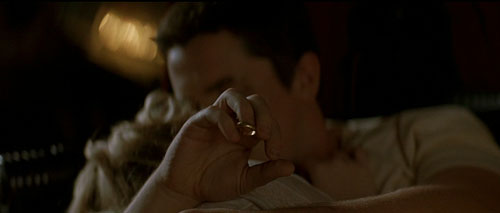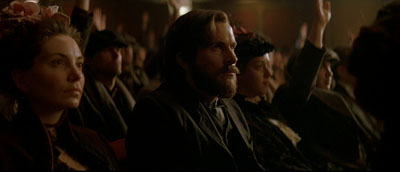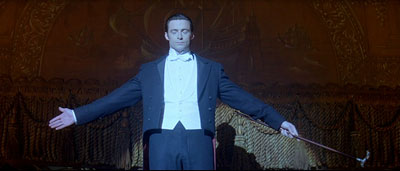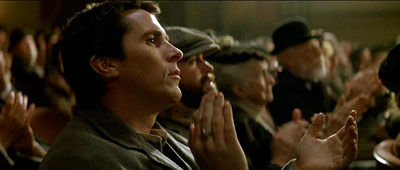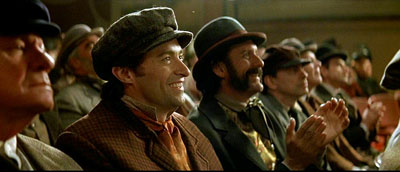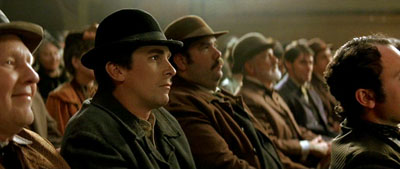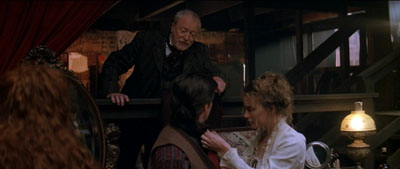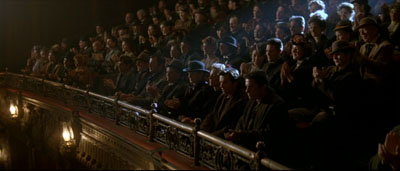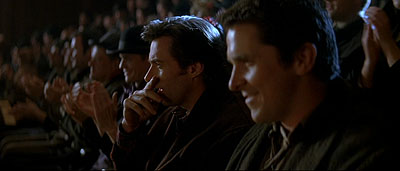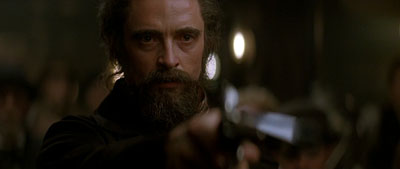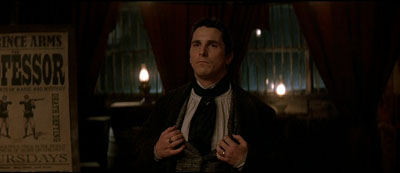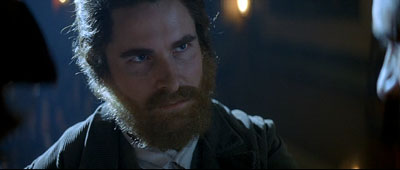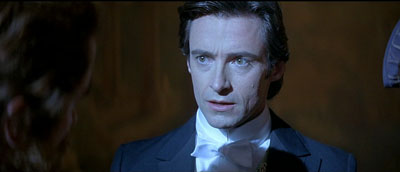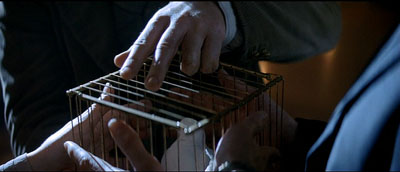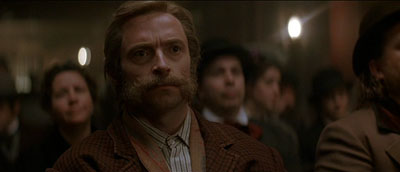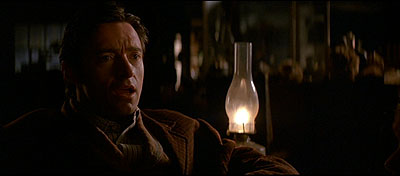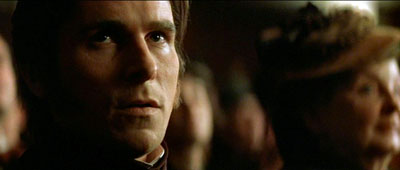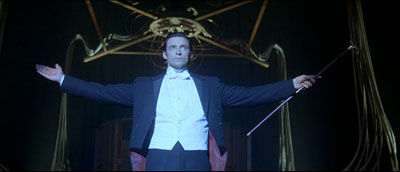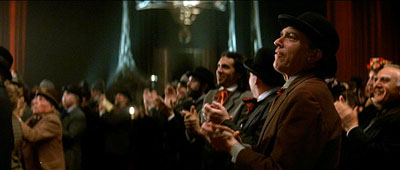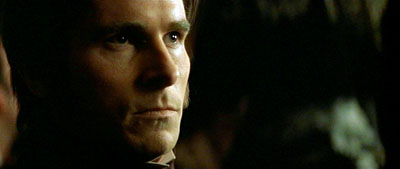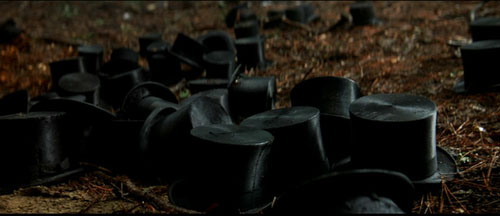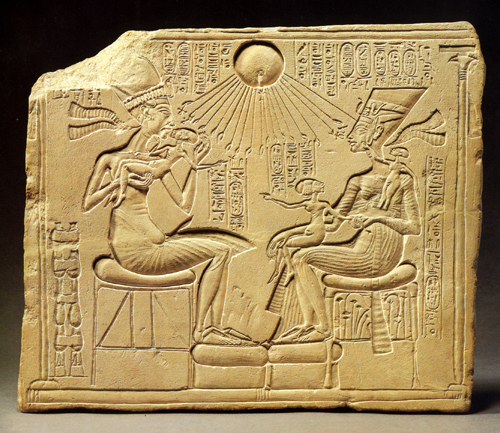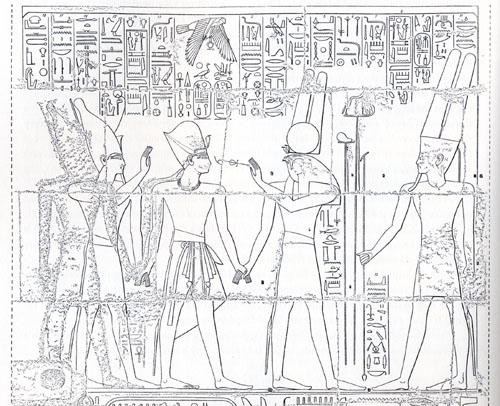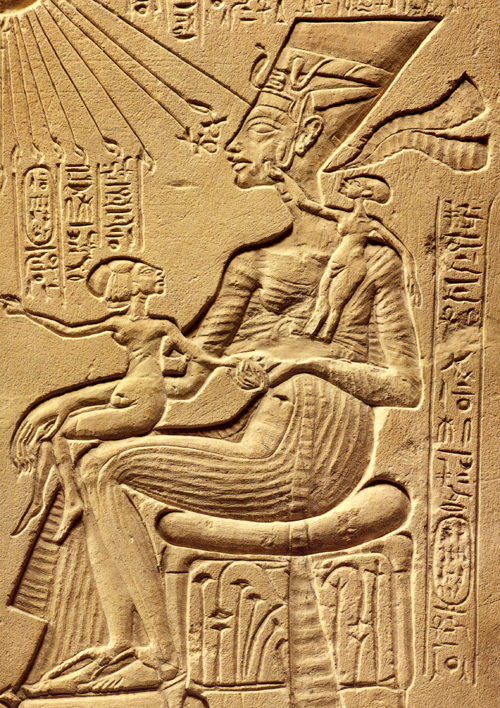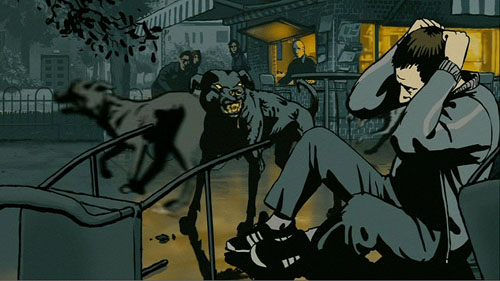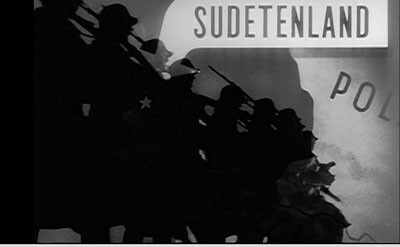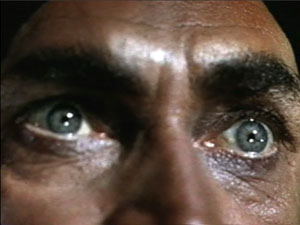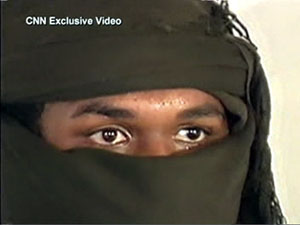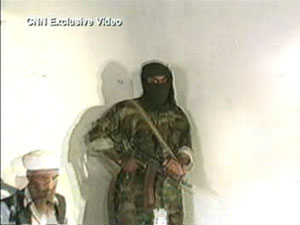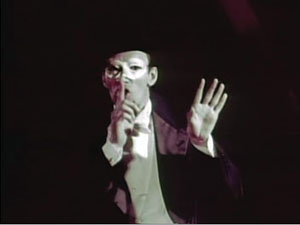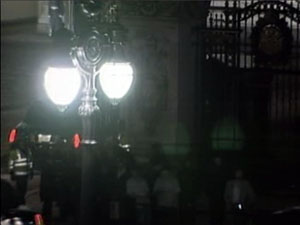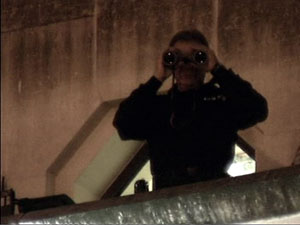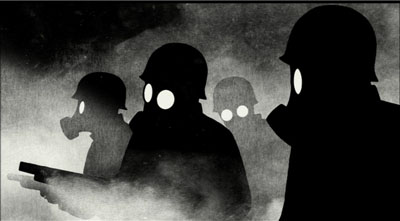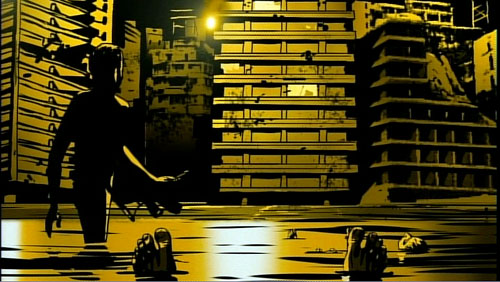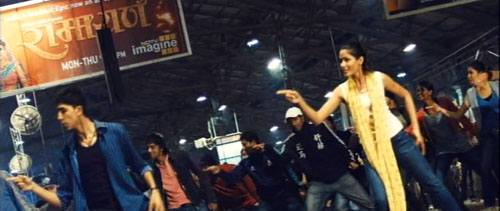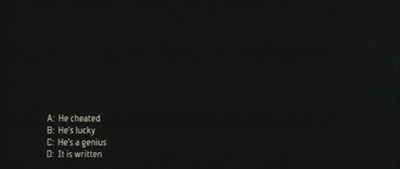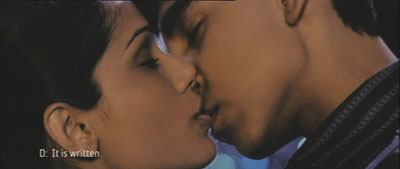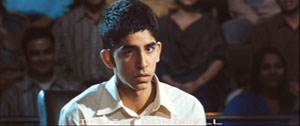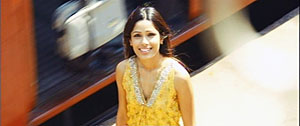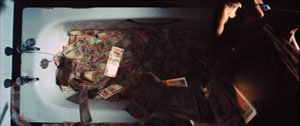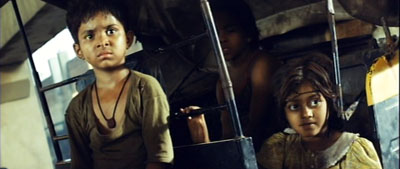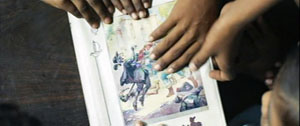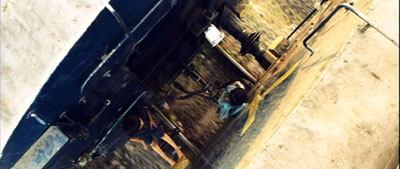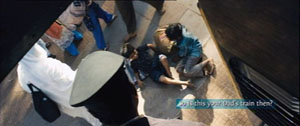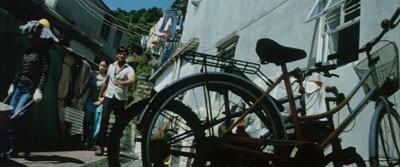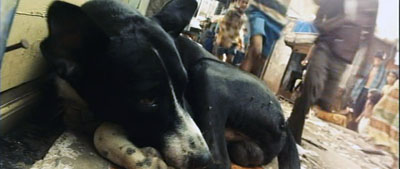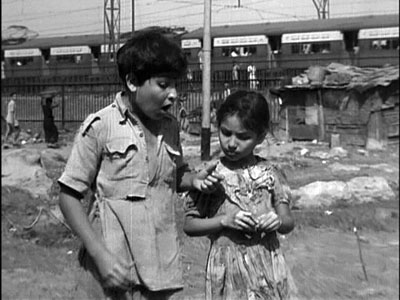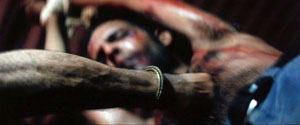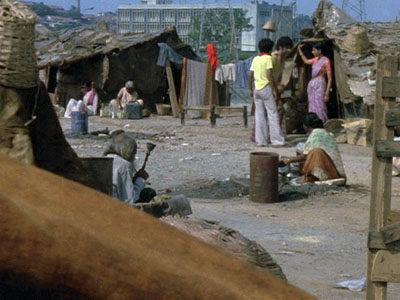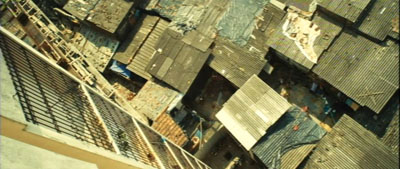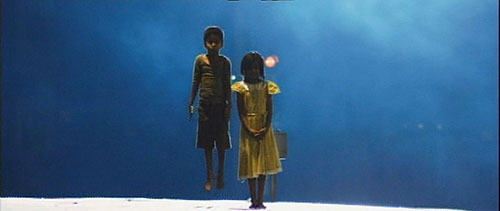Archive for the 'Film technique: Editing' Category
Niceties: how classical filmmaking can be at once simple and precise
DB here:
A film academic once complained that I was too preoccupied with “formalistic niceties.” So here I go again. But read no further if you haven’t seen Christopher Nolan’s The Prestige.
Dueling magicians: The film’s premise might be considered high-concept. In turn-of-the-century London, two young conjurers launch their careers with different attitudes toward their craft. Robert Angier favors audacious showmanship, while Alfred Borden is committed to finding a trick that will baffle the experts. Their rivalry is ignited when Alfred accidentally kills Angier’s wife during a dangerous underwater stunt. Their struggle peaks around each one’s supreme trick: transporting himself from one point to another instantaneously.
The item that attracts my attention today is established in the film’s opening sequence. As the voice of Cutter (Michael Caine) explains a magic trick’s three acts, we see a climactic confrontation between the competitors. Hoping to discover Robert’s secret, Alfred watches the Real Transported Man performance from the audience.
As Cutter’s narration mentions “a man,” the camera picks out Alfred in the crowd. Cut to Robert onstage, a shift that establishes the two as our protagonists.
What interests me is the view of the bearded Alfred: a medium-shot framing him nearly in profile facing right. This framing will be repeated, but varied, when Alfred’s voice-over diary entry introduces both him and Robert as apprentices, working as audience shills for another magician:
We were two young men at the start of a great career—two young men devoted to an illusion, who never intended to hurt anyone.
The new shot parallels the introduction of Alfred in the first scene, but varies it. Again we see Alfred in the audience, but now without a beard, and the camera tracks rightward to show Robert in another row.
In this sequence, our protagonists are connected by a camera movement rather than the cut employed in the opening. The two men’s reactions—Robert grinning (his wife is onstage), Alfred more pensive—add to the characterizations that we will see played out.
This simple camera motif gets varied further in the course of the film. The disastrous immersion illusion that drowns Robert’s wife is initiated by another tracking shot of the two men in the audience, a variation of the earlier shot.
The new combination starts with Robert and ends on Alfred. At this point, not only are the two men linked but they replace one another. If you want to push your luck, you could say that this variant quietly affirms the film’s overall dynamic of substitution (doubles, twins, clones).
Earlier, a contrasting way of showing the men in an audience is given us when they attend a performance of the wizard Chung Ling Soo. Cutter provides a dialogue hook, warning Robert that “the blokes at the ends of row three and four” can see him kissing his wife’s leg.
Cut to our protagonists, sitting at the end of a row watching the Chinese magician.
A nicety: Now the men are sitting side by side and facing left rather than right. Just through camera placement and character position, we know we’re in a different performance, one in which our apprentices play no role.
As they study the trick, Nolan gives us another characterizing shot: Robert is amazed, but Alfred grins: He’s worked out Chung’s secret.
What would have happened if Nolan had framed the men sitting apart and/or facing to the right? For an instant we might have thought we were back in the act they shill for. Simple but reiterated differences assure immediate comprehension: medium shot/ long shot, looking rightward/ looking leftward, men in different rows/ men in the same row. Just as the repeated framings of their own act clarify the situation, so do these little polarities. Call it redundancy, if you like, but it’s also precision and economy.
With Julia’s death, the men become enemies. But each will still slip into the audience of the other’s performances. From now on, the magician is always on the right, the onlooker on the left. Nolan and company could have handled their rivalry in camera setups that exactly mimic the early ones. Instead, a new pattern of parallels comes into play, building on the earlier ones but different enough to heighten the symmetries.
The new pattern is set up by restricting our range of knowledge. First, we are attached to Alfred when he performs his bullet catch in a barroom theatre. Robert, seeking vengeance for Julia’s drowning, steps up to spoil the trick, but we don’t know he’s there until Alfred does, and then it’s too late.
Similarly, we’re restricted to Robert’s range of knowledge when he tries to execute his disappearing dove trick. Only when Alfred is about to trigger the collapsing cage—killing the dove and wounding a lady from the audience—does Robert realize that his adversary has struck back.
Another nicety: The two shots of each man in similar disguises, seen in 3/4 view, reset the stylistic parameters. But the image of the bearded Alfred is given extra punch through a tilt up from his missing fingers–the result of the parallel, bullet-catch scene before.
The whole pattern shifts yet again when Robert sneaks in to watch Alfred’s Transported Man illusion. We get a shot of him (in a beard again) that fuses two of the cues from the earlier scenes: He’s in the audience, as in the early sequences, but he’s shown from an angle congruent with that of the earlier beard shots.
And perhaps we can take the shot of Robert at home, telling of his amazement at Alfred’s illusion, as an echo of the initial prototype: A magician staring intently rightward at a dazzling trick played out offscreen, but now in memory.
Robert returns from Colorado with the Tesla-designed “Real Transported Man,” and Alfred’s visit to watch the stunt reworks the givens of this pattern yet again. Alfred is seated, minimally disguised, in the standard audience spot looking right, but he is not in profile and the camera position is much closer than before. The answering shot of Robert onstage recalls the gesture we saw at the film’s outset and anticipates what we will see when that opening scene is replayed, with the wicked Alfred climbing onstage.
At the close of the trick, yet one more variant: Robert appears in the rear balcony and the crowd all turns to watch him off left.
After a glance back, Alfred turns away, looking right–the first time any character has flinched from the performance. His puzzlement is mixed with anger (at last a trick he can’t see through), a less charitable response than we saw in Robert’s stunned fireside recollection of Alfred’s Transported Man.
The things held constant, such as camera placement and position in the locale, set off the differences in characters’ disguises and reactions, while this shot carries faint echoes of our very first view of Alfred during Cutter’s voice-over monologue. That view, and its answering shot of Robert in the spotlight, will recur when Robert’s pseudo-death is replayed.
Nolan’s audacious film is built out of more marked parallels than these, but I wanted merely to highlight the ups and downs of one small pattern. Many films work varied repetitions like these into their shot-by-shot texture. Back in the 1930s, Eisenstein saw this possibility clearly, as I try to show in my book on his work. In the 1960s and 1970s, Raymond Bellour called our attention to such patterns in films by Hitchcock, Hawks, and Minnelli. His collection of essays The Analysis of Film includes pioneering studies of how fine-grained such things can become.
I wouldn’t go as far as Bellour does in seeing varied repetition as the motor force of classical filmmaking, but it surely plays an important role. What he takes as a manifestation of pure textual difference I’m inclined to psychologize: these differences help the audience understand, usually without awareness, the ongoing narrative dynamic and have the extra payoff of creating tacit narrative parallels. But from either perspective, object-centered or response-centered, studying such microforms is enlightening. It’s a way to understand films as wholes, dynamic constructions that shift their shapes across the time of their unfolding. Moreover, by examining things this closely, we can try to understand not only how this or that film works, but how this or that film relies on principles distinctive of a filmmaking tradition. Consider this another plug for poetics.
I’d add that such principles neatly fuse two pressures: toward narrative coherence and comprehension on the one hand, and toward production efficiency on the other. It’s cheaper and easier to repeat camera setups if you can. Artistic economy and financial economy can work together, nicely.
Speaking of repetitions….
The eyeline match goes way, way back
Kristin here—
It’s late January as I write this entry, and in about a month, I’m due in Egypt for my annual three weeks of volunteer work on the Amarna Project at Tell el-Amarna, in Middle Egypt. (For the project’s website, see here, and for my part in it, click on “Recent Projects,” then “Material Culture,” and finally “Statuary.”) So as not to leave David with the entire blogging burden during that period, I’m writing this to be posted during my absence.
Given the occasion, I decided to write about a topic that has popped into my mind now and then: a little connection I observed between techniques of ancient Egyptian art and those of continuity film editing. In their reliefs, Egyptian artists were very conscious of the directions of figures’ gazes, and their strove in most cases to match the orientation of the accompanying hieroglyphs to those directions. This topic is not only appropriate, but it gives me a chance to show off my new hieroglyphic font—and to practice composing texts with it.
The connection between eyelines in reliefs and in film editing first occurred to me several years ago when our colleague Noël Carroll was giving a talk in the film-studies colloquium in the Dept. of Communication Arts here at the University of Wisconsin-Madison. He dealt with eyeline matches, or glance/object editing and took a cognitive-studies approach.
Noël’s argument was that such editing is not an arbitrary convention and that it draws upon an “innate perceptual behavior” shared by humans to look not just at other people but also at what those people are looking at. (I’m quoting here from the publication of his talk as “Toward a Theory of Point-of-View Editing: Communication, Emotion, and the Movies,” in his 1996 collection, Theorizing the Moving Image, from Cambridge University Press.) This tendency naturally manifests itself when babies begin at two to three months to follow the directions of their parents’ gazes. He claims that eyeline matching “can function communicatively because it is a representational elaboration of a natural information-gathering behavior” and also that such a link to our everyday perception helps make continuity editing easy to grasp.
If we can find comparable sorts of devices in art of a different era and culture, those devices help support claims about “cultural universals.” These are patterns of perception that all cultures share, though they will manifest themselves in art in different ways. Let’s take a look at a sort of eyeline matching that’s used in Egyptian reliefs. Only here it’s not an eyeline and a seen object being matched. It’s a match between an eyeline and the direction its accompanying hieroglyphs face.
Hieroglyphs and their orientation
First, let me get a pet peeve out of the way. A lot of people these days call hieroglyphs “hieroglyphics.” There is no such word, or shouldn’t be. “Hieroglyphic” is an adjective, as in “hieroglyphic text” or “hieroglyphic inscription.” But don’t just take my word for it; look under Etymology in the Wikipedia entry on hieroglyphs. (I note with annoyance that my spell-checker doesn’t highlight “hieroglyphics,” but it does think “eyeline” is wrong.)
Now, about directions. Egyptian hieroglyphs can be written horizontally or vertically, facing left or right. The default orientation is facing right, to be read right to left. How do you know which direction they’re facing? Even if you can’t read hieroglyphs, just look at the signs representing living things. Birds, people, animals, bugs, with rare exceptions they all face the front of the text.
There are all sorts of complicated exceptions to the rightward orientation. The late Henry George Fischer, curator of Egyptology at the Metropolitan Museum of Art, wrote a large book on the subject: The Orientation of Hieroglyphs, Part 1. Reversals (Alas, he never wrote Part 2.)
As Fischer says at the outset, “It is essential to stress the fact that Egyptian art and writing are interrelated to a degree that is unparalleled in any other culture. For it is from this fact that the orientation of hieroglyphic texts derives its logic.” And Egyptian art, despite its strangeness to many eyes, is intensely logical. Each person, creature, and object portrayed in relief will be shown from its most characteristic, recognizable view, whether that be in profile (such as a person’s face, legs, and stomach) or frontal (that person’s eye and shoulders).
In reliefs, the hieroglyphic texts in reliefs function as labels and descriptions of the things depicted or to quote the words of the people present. Hence, logically, the particular inscription relating to one person, creature, or object depicted will face the same direction as it does.
Two straightforward examples
The image below is a detail from a false door (the entrance and exit for the dead person’s soul in a tomb). It comes from an Old Kingdom tomb at Saqqara (5th Dynasty, roughly 2453 BCE). The relief depicts a husband, Nikaure, and wife, Ihat, along with two of their children.
Egyptian Museum, Cairo, inventory CG 1414
The pair sit opposite each other across a table full of offerings: long loaves of bread, portrayed vertically even though they are assumed to lie on the table. The two columns above Nikaure face rightward, as does he. They give his official titles and name. The two above Ihat face left and do the same for her. The son at the left faces right, as does the text above him, and his sister, at the right, faces leftward, as do her hieroglyphs. Despite the fact that this particular door belongs to Ihat, there is a slight male bias here, since the list of offerings above the table face right, as he and his son do—the favored, “stronger” orientation for hieroglyphs and people.
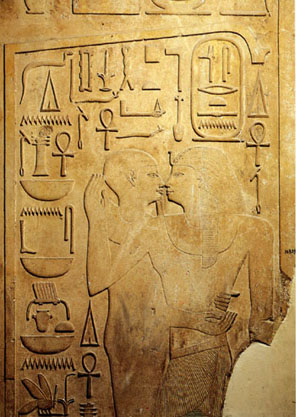 The basic conventions of Egyptian art were amazingly stable for a period of about three thousand years. We find the same principles in the Middle Kingdom. This relief (Egyptian Museum, Cairo, inventory JE 36809) on a column shows Senwosret I (12th Dynasty, reigned 1971-1929 BCE) being embraced by a statue of the god Ptah in its shrine. You wouldn’t think that statues embrace people, but pharaohs were considered divine and could communicate with gods’ statues in temples. The king is at the right, facing left. His name is in the oval cartouche above his head, and the columns of signs at either side of it give some of his titles. All face left.
The basic conventions of Egyptian art were amazingly stable for a period of about three thousand years. We find the same principles in the Middle Kingdom. This relief (Egyptian Museum, Cairo, inventory JE 36809) on a column shows Senwosret I (12th Dynasty, reigned 1971-1929 BCE) being embraced by a statue of the god Ptah in its shrine. You wouldn’t think that statues embrace people, but pharaohs were considered divine and could communicate with gods’ statues in temples. The king is at the right, facing left. His name is in the oval cartouche above his head, and the columns of signs at either side of it give some of his titles. All face left.
The rest of the signs face right. They identify Ptah and describe all the things he’s giving the king: life, dominion, stability, health, and happiness. The column at the far left is a direct quotation of the god’s words. As in these two examples, almost any relief where figures are present facing different directions, the orientation of the hieroglyphs will be determined by which one they refer to. Obviously the Egyptians considered this sort of directional consistency very important.
Facing one way, looking the other
Indeed, the directions in which figures’ faces and eyes were turned seems to have been of particular importance. It’s not uncommon for a figure to be facing one way and looking back. In that case, that figure’s hieroglyphs will face backward as well.
The relief below reveals the logic of this device very well. Two gods, Atum at the right and Montu with the falcon head (not all falcon-headed gods are Horus) are leading Rameses III to the king of the gods, Amen. (I copied this from Fischer’s book, and unfortunately he doesn’t specify where this relief is.) As they proceed, Montu turns back to hold the signs for “life” and “dominion” to the king’s face. The five right-most columns of text above refer to Amen and mimic him in facing leftward; they represent his speech to the king. The next five represent Montu’s speech and, because his eyes look leftward, so do the hieroglyphs. But not the little column of text in front of his stomach and kilt. That describes his action of leading the pharaoh to Amen, so those signs, written beside the part of his body facing right, also face right. Charmingly logical.
That sort of thing is one small part of what makes Egyptian art so appealing to me. Perhaps it gives you a better feel for why Fischer claimed that Egyptian art integrates writing and pictorial representation more thoroughly than that of any other culture. It also bolsters David’s recent entry about how studying the techniques and conventions of an artform enhances one’s enjoyment of individual artworks.
Amarna examples
My favorite examples of head-turning reversed hieroglyphs come, not surprisingly, from the period I study, the Amarna era (18th Dynasty, New Kingdom, roughly 1350 BCE). One trait of Amarna art is its relatively casual depiction of the royal family. Previously the king had not been shown “behind the scenes,” playing with his children. Compare the Old Kingdom relief of Nikaure and Ihat, seated stiffly with their children at attention behind them, with the stela at the top of this entry. There the pharaoh Akhenaten lifts his eldest daughter, Meritaten, to kiss her. Opposite him sits his wife Nefertiti, holding the second daughter, Meketaten, on her lap, and balancing her third, Ankhesenpaaten, who stands on her arm or hip, playing with the decoration on Nefertiti’s familiar tall, flat crown. (A repaired crack has destroyed the child’s feet and some other elements of the relief). There’s a similar relief in the Louvre, by the way, where Nefertiti and at least two of the daughters sit on Akhenaten’s lap, but unfortunately only the lower part survives.
This stela is my favorite piece of Amarna art. I must confess that standing back in 1992 in the Ägyptisches Museum in Berlin and studying this sentimental little image (inventory 14145) was what finally suckered me into an obsession with the art of the era. It’s not just the appeal of the family scene, though. There’s an underlying complexity and innovativeness about this piece that makes it unique in the history of Egyptian art. It’s also not just sentimental. Such a stela would have stood in a private chapel in the garden of a rich family. The fecundity and nurturing shown in the image would be seen as indicative of the pharaoh’s protective role toward his country.
As is typical of Egyptian art, each figure has a label identifying him or her. Akhenaten’s and Nefertiti’s names and titles are in the vertical columns at the top, alongside the name and titles of their sole god, the Aten, or globe of the sun, which casts its life-giving rays down upon the group. Literally life-giving, since two of the rays’ little hands hold ankh-signs to the king’s face, and another two do the same for Nefertiti. Each daughter, though, has a label identifying her, all in the very formulaic phrases used on endless reliefs for this purpose.
Here’s a detail of the part of the relief I want to focus on:
In contrast to the beautiful carving of the figures, the hieroglyphs here are rendered very badly, and it’s partly because they are so formulaic that one can read them all. I’ve used my new font program to lay them out legibly so you can see which way the inscriptions face. (The font couldn’t cram the four nfr-signs that appear side-by-side in Nefertiti’s name into the cartouche, so I settled for putting them on two lines.)
In the text running down the side, the youngest daughter is described: “King’s daughter, Ankhesenpaaten [i.e., “She who lives for the Aten”] of his body [i.e., Akhenaten’s biological offspring], whom he loves, born to the Great Royal Wife, Nefertiti, may she live forever and continuously.” The two other daughters have the same texts with their names substituted.
I’ve analyzed this stela in print, suggesting an interpretation of the brief narrative action that is going on in the scene (“Frontal Shoulders in Amarna Royal Reliefs: Solutions to an Aesthetic Problem,” The Journal of the Society for the Study of Egyptian Antiquities Vol. XXVII [1997, published 2000]: 79-98 and Pls. IV-VII). All I’m concerned with here is the fact that Meketaten has turned her head to look at her mother while pointing across at her father and sister. The short columns of text above her have been reversed accordingly:
There are other Amarna reliefs where a daughter turns her head, including one where the upper part of the princess is missing, and we can only tell she was turning to look at her mother because the few surviving hieroglyphs face the opposite direction from her feet. The reversal isn’t used in every case where a princess turns her head. In more formal offering scenes, where the princesses stand in a group behind their parents, a continuous row of short vertical columns above them gives the name and title for each. With all the rows lined up this way, the reversing of one daughter’s signs would look odd, and so the Egyptian artist kept all the columns facing the same direction. That’s another convention of Egyptian art: keep the graphic layout of the signs neat and pictorially appealing. They’re an important part of the overall image.
Reversed hieroglyphs and eyeline matches
I’m not trying to claim that Egyptian reliefs are just like film because the hieroglyphs are oriented by which was the figures are facing. There’s nothing comparable to an eyeline match in such images, since we see all the figures of a scene present at the same time, always depicted from head to toe. There is no need to match a figure’s eyeline to what he or she is looking at, since that, too, is present in the scene. There is no “offscreen space” in Egyptian reliefs.
Still, the Egyptians matched the orientation of hieroglyphs not just to the general direction a figure was facing but also to the specific eyeline created by head position. There was a logic to this, based on the fact that the direction of the gaze was deemed important and hence could be used to organize important elements of the composition of a scene—a static one in this case rather than one unrolling temporally across separate shots. That a culture so different from our own could come up with an artistic convention reminiscent of a technique in classical filmmaking suggests to me that claims about the naturalistic basis of eyeline matching and shot/reverse shot have merit.
Showing what can’t be filmed
DB, again:
People tend to think that documentary films are typified by two conditions. First, the events we see are unstaged, or at least unstaged by the filmmaker. If you mount a parade, the way that Coppola staged the Corpus Christi procession in The Godfather Part II, then you aren’t making a documentary. But if you go to a town that is holding such a procession and shoot it, you are making a doc—even though the parade was organized to some extent by others. Fiction films stage their events for the camera, but documentaries, we tend to think, capture spontaneous happenings.
Secondly, in a documentary the camera is seizing those events photographically. The great film theorist André Bazin saw cinema’s defining characteristic as its capacity to record the actual unfolding of events with little human intervention. All the other arts rely on human creation at a basic level: the novelist selects words, the painter chooses colors. But the photographer or filmmaker employs a machine that impassively records what is happening in front of it. “All the arts are based on the presence of man,” Bazin writes; “only photography derives an advantage from his absence.” This isn’t to say that cinema can’t be artful, only that it offers a different sort of creativity than we find in the traditional arts. The filmmaker works not with pure imaginings but obstinate chunks of actual time and space.
Given these two intuitions, unstaged events and direct recording of them, it would seem impossible to consider an animated film as a documentary. Animated films consist of almost completely staged tableaus—drawings, miniatures, clay, even food or wood shavings (in the works of Jan Svankmajer). And animated movies offer no recording in Bazin’s sense of capturing the flow of real time and space. These films are made a frame at a time, and the movement we see onscreen doesn’t derive from movement that occurred in reality. And of course you can make an animated film without a camera, for instance by painting directly on film or assembling computer-generated imagery.
Recently, however, we’ve been faced with animated films that claim documentary validity. How is this possible? Maybe we need to rethink our assumptions about what documentary is.
In certain types of documentaries, especially those in the Direct Cinema or cinéma vérité traditions, the assumption that we’re seeing spontaneously occurring events holds good. But a documentary can consist wholly of staged footage. Think back to those grade-school educational shorts showing a tour of a nuclear power plant. Every awkward passage of dialogue recited by the hard-hatted, white-coated supervisor was scripted. The whole show was planned and rehearsed, but that doesn’t detract from the factual content of the film.
Go further. Recall those attack maps that are shown in war films, tracing the progress of an army through enemy terrain. Now imagine an entire film made of those animated maps. The maps might even be enhanced with a few cartoon images, as in the above shot from one of the Why We Fight films. The film would be entirely designed, presenting no spontaneous reality being captured by the camera. Yet it would plainly be a documentary, telling us that, say, the Germans marched into the Sudetenland in 1938 and proceeded on to Poland. So we don’t need photographic recording of actual events to count a film as a documentary either. Both the staging and the recording conditions don’t have to be present for a film to count as a documentary.
I’m not saying that the claims advanced in my nuclear-power film or my attack-map movie would necessarily be accurate. They might be erroneous or inconclusive or false. But that possibility looms for any documentary. The point is that the films, presented and labeled as documentaries, are thereby asserting that the claims and conclusions are true.
Film theorist Noël Carroll defines documentary as the film of “purported fact.” Carl Plantinga makes a similar point in saying that documentaries take “an assertive stance.” Both these writers argue that we take it for granted that a documentary is claiming something to be true about the world. The persons and actions are to be taken as representing states of affairs that exist, or once existed. This is not something that is presumed by The Gold Rush, Magnificent Obsession, or Speed Racer. These films come to us labeled as fictional, and they do not assert that their events and agents ever existed.
This isn’t just a case of a professor stating something obvious in a fancy way. Once we see documentary films as tacitly asserting a state of affairs to be factual, we can see that no particular sort of images guarantees a film to be a doc.
Take the remarkable documentaries made by Adam Curtis. These are in a way very old-fashioned. Blessed with a voice whose authoritative urgency makes you think that at last the veils are being ripped away, Curtis mounts detailed arguments framed as historical narratives. Freudian theory shaped the emergence of public relations, which was in turn exploited not just by business but by government (Century of the Self). Islamic fundamentalism grew up intertwined with US Neoconservatism, both being reactions to perceptions that the West was becoming heartlessly materialistic (The Power of Nightmares). Mathematical game theory came to form politicians’ dominant conception of human behavior and civic community (The Trap). The almost uninterrupted flow of Curtis’s voice-over commentary could be transcribed and published as a piece of nonfiction. True, there are some interpolated talking heads, but those experts’ statements could be printed as inset quotations.
What’s particularly interesting is that Curtis’ rapid-fire declamation accompanies images that often seem not to illustrate it, or at least not very firmly. Like the found footage in the preacher’s sermon “Puzzling Evidence” in True Stories, Curtis’ images are enigmatic, tangential, or metaphorical.
Here are a few seconds from the start of The Power of Nightmares. Eyes are staring upward, as if possessed.
We hear: [Our politicians] say that they will rescue us from dreadful . . .
The eyes are replaced by a shot of a man wearing a cowl, and as this image zooms back the commentary continues.
. . . dangers that we cannot see and do not . . .
Cut to a magician or mime demanding silence.
. . . understand.
Cut to rockets being fired.
And the greatest danger . . .
Cut to a procession of cars, seen from above, rounding a corner into a government compound at night.
. . . of all is international terrorism.
Cut to shot of security agent staring at us.
The ominous, not to say paranoid, tenor of the sequence is aided by the unexpected juxtapositions. For instance, you’d think that the shot of the iconic terrorist (anonymous, with automatic weapon) would be synchronized with the final line of the commentary, referring to “international terrorism.” Instead the commentary links the mention of terrorism to an image of government deliberation, and then to an image of surveillance (aimed at us, but also perhaps suggesting the previous high-angle shot was the spy’s POV). The wild-eyed close-up might belong to a terrorist, but is accompanied by claims about rescuing us from fearsome threats, so the eyes could also belong to someone panicked–especially since they contrast immediately with the sober eyes of the gunman in the cowl. Perhaps the first shot represents the fearful public ready to be led by the politicians playing on fear. And the insert shot of the mime becomes sinister but also comic, perhaps debunking the official position that our dangers are unseen and unknowable. In all, the sequence bubbles with associations that are less fixed and more ambiguous than we’re likely to find in a more orthodox documentary, like Jarecki’s Why We Fight.
My point isn’t to analyze the image/ sound relations in Curtis’s work, a task that probably demands a whole book. (This sequence takes a mere eleven seconds.) I simply want to propose that regardless of what pictures Curtis shows, his films are documentaries in virtue of a soundtrack constructed as a discursive argument that makes truth claims. The picture track often works on us less as supporting evidence than as a stream of associations, the way metaphors or analogies give thrust to a persuasive speech.
Just as we could have an account of Germany’s 1938 invasion of Czechoslovakia presented in cartoon form, we could imagine The Power of Nightmares illustrated with political cartoons. Once we’ve pried the image track loose from the assertions on the soundtrack, anything goes.
One example much on our minds now is Waltz with Bashir. Ari Folman interviews former Israeli soldiers. But instead of using film footage of their conversations and, say, still photos of the events in Lebanon they took part in, he provides (until the final sequence) drawings a bit in the Eurocomics mold of Tardi or Marc-Antoine Mathieu. The result takes the form of a memoir, admittedly. But in both literature and cinema, memoir is a nonfiction genre.
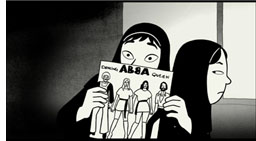 Another memoir supports the point. Marjane Satrapi’s autobiographical graphic novels, Persepolis and Persepolis 2, assert factual claims about her life. The claims are presented as drawings and texts rather than simply as texts, but that doesn’t change the fact that she presents agents and actions purported to have existed. True, on film the people whom she remembers are represented through voice actors speaking lines she wrote. But as with written memoirs (especially those that claim to remember conversations taking place fifty years ago), we can always be skeptical about whether the events presented actually took place.
Another memoir supports the point. Marjane Satrapi’s autobiographical graphic novels, Persepolis and Persepolis 2, assert factual claims about her life. The claims are presented as drawings and texts rather than simply as texts, but that doesn’t change the fact that she presents agents and actions purported to have existed. True, on film the people whom she remembers are represented through voice actors speaking lines she wrote. But as with written memoirs (especially those that claim to remember conversations taking place fifty years ago), we can always be skeptical about whether the events presented actually took place.
Turning Satrapi’s published memoir into an animated film did not change its status as a documentary. If we had contrary evidence, we could charge her with fibbing about her family life, her rebelliousness, or her life in Europe. But we’d be questioning the presumptive assertions the film makes, not the fact that it is drawn and dubbed rather than photographed from life.
We’re tempted to see the animation in these films as adding a level of distance from reality. We’re so used to fly-on-the-wall documentaries that we may be suspicious of the cobra-like caricatures of the female teachers in Persepolis or the hallucinatory dawn bombardment in Bashir. Yet animation can show things, like the Israeli veterans’ dreams, that lie outside the reach of photography. And the artificiality doesn’t dilute the claims about what the witnesses say happened any more than does purple prose in an autobiography. In fact, the stylization that animation bestows can intensify our perception of the events, as metaphors and vivid imagery in a written memoir do.
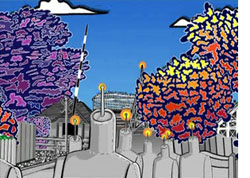 I realize I’m pointing toward a slippery slope here. Strip off the image track from Aardman‘s Creature Comforts and you have impromptu recordings of ordinary people talking about their lives. Those monologues could have been accompanied by documentary-style talking heads. Does that make Creature Comforts a documentary? I’d say not because the film doesn’t come to us labeled that way; it’s presented as comic animation using found soundtracks (like the movie based on the Lenny Bruce routine Thank You Mask Man). Then there are Bob Sabiston‘s rotoscoped films like Waking Life and The Even More Fun Trip, recently released on Wholphin no. 7. The latter (left) takes another documentary form, the home movie, as the basis for its animation. This seems to me an instance where the documentary category has the edge, but it’s a surely a borderline case.
I realize I’m pointing toward a slippery slope here. Strip off the image track from Aardman‘s Creature Comforts and you have impromptu recordings of ordinary people talking about their lives. Those monologues could have been accompanied by documentary-style talking heads. Does that make Creature Comforts a documentary? I’d say not because the film doesn’t come to us labeled that way; it’s presented as comic animation using found soundtracks (like the movie based on the Lenny Bruce routine Thank You Mask Man). Then there are Bob Sabiston‘s rotoscoped films like Waking Life and The Even More Fun Trip, recently released on Wholphin no. 7. The latter (left) takes another documentary form, the home movie, as the basis for its animation. This seems to me an instance where the documentary category has the edge, but it’s a surely a borderline case.
Animated documentaries are likely to remain pretty far from our prototype of the mode. Still, we should be grateful that even imagery that seems to be wholly fictional—animated creatures—can present things that really happen in our world. This mode of filmmaking can bear vibrant witness to things that cameras might not, or could not, or perhaps should not, record on the spot.
André Bazin’s arguments for the documentary basis of cinema are set out in “The Ontology of the Photographic Image,” in What Is Cinema? ed. and trans. Hugh Gray (Berkeley: University of California Press, 1967), 9-16. Noël Carroll’s argument that documentaries are framed as presenting “purported fact” can be found in Theorizing the Moving Image (Cambridge: Cambridge University Press, 1996), 224-259. On the “assertive stance” of documentaries, see Carl Plantinga, Rhetoric and Representation in Nonfiction Film (Cambridge: Cambridge University Press, 1997), 15-25. Errol Morris interviews Adam Curtis here. Thanks to Mike King for pointing me toward The Even More Fun Trip.
PS 10 March: Harvey Deneroff writes:
Very much enjoyed your post on animated documentaries, a topic of some interest to and often discussed in the animation studies community. There was a panel on it during last year’s Society for Animation Studies conference and there will also be one at this year’s as well.
Two recent Oscar recipients for Best Animated Short Subject are also documentaries: Chris Landreth’s wonderful computer animated Ryan (produced by the NFB about animator Ryan Larkin, and features a lot of talking heads) and John Canemaker’s The Moon and the Son: An Imagined Conversation, which is about Canemaker’s father and mixes animation with home movies and photographs.
At least two winners in the Oscar Documentary Short Subject category were largely animated: Chuck Jones’ So Much for So Little (WB, 1949, which I believe was made for the US Public Health Service) and Norman McLaren’s Neighbours. The Story of Time, a 1951 British documentary which featured stop motion animation was nominated in the same category.
Also, the International Leipzig Festival for Documentary and Animated Film includes a section for animated documentary films.
Thanks to Harvey for this. I’m not sure I’d categorize Neighbours as a doc, but it’s a long time since I’ve seen it. On Harvey’s site he also has a note quoting Ari Folman on the difficulty of funding animated docs. And thanks to Ryan Kelly and Pete Porter for reminding me of Winsor McCay’s Sinking of the Lusitania from 1918.
Slumdogged by the past
DB here:
In graduate school a professor of mine claimed that one benefit of studying film history was that “you’re never surprised by anything that comes along.”
This isn’t something to tell young people. They want to be surprised, preferably every few hours. So I rejected the professor’s comment, and I still think it’s not a solid rationale for studying film history. But I can’t deny that doing historical research does give you a twinge of déjà vu.
For instance, the film industry’s current efforts to sell Imax and 3-D irresistibly remind me of what happened in the early 1950s, when Hollywood went over to widescreen (Cinerama, CinemaScope, and the like), stereophonic sound, and for a little while 3-D. Then the need was to yank people away from their TV sets and barbecue pits. Now people need to be wooed from videogames and the Net. But the logic is the same: Offer people something they can’t get at home. It’s 1953 once more.
So historians can’t resist the “Here we go again” reflex. But they shouldn’t turn that into a languid “I’ve seen it all before.” Because we can genuinely be surprised. Occasionally, there are really innovative movies that, no matter how much they owe to tradition, constitute milestones. In my view, Kiarostami’s Through the Olive Trees, Hou’s City of Sadness, Wong’s Chungking Express, Tarr’s Satantango, and Tarantino’s Pulp Fiction are among the 1990s examples of strong and original works.
More often, the films we see draw on film history in milder ways than these milestones. But this doesn’t mean that these movies lack significance or impact. We can be agreeably surprised by the ways in which a filmmaker energizes long-standing cinematic traditions by blending them unexpectedly, tweaking them in fresh ways, setting them loose on new material. And the more you know of those traditions and conventions, the more you can appreciate how they’re modified. Admiring genius shouldn’t keep us from savoring ingenuity.
Which brings me to Slumdog Millionaire. I happen to like the film reasonably well. Part of my enjoyment is based on seeing how forms and formulas drawn from across film history have an enduring appeal. Many people whose judgments I respect hate the movie, and they would probably call what follows an ode to clichés. But I mean this set of notes in the same spirit as my comments on The Dark Knight (which I don’t admire). Even if you disagree with my predilections, you may find something intriguing in Slumdog’s ties to tradition. These ties also suggest why the movie is so ingratiating to so many.
Warning: What follows contains plot spoilers, revelatory images, and atrocious puns.
Slumdog and pony show
Adaptation is still king. Almost as soon as movies started telling stories, they were borrowing from other media. Many of this year’s Oscar candidates are based on plays, novels, and graphic novels. Slumdog is a redo of Vikas Swarup’s 2005 novel Q & A. The book provides the basic situation of a poor youth implausibly triumphing on a version of Who Wants to be a Millionaire? The novel also lays down the film’s overall architecture: in the present, the hero narrates his past, tying each flashback to a round of the game and a relevant question. In the novel, the video replays are described, but of course they’re shown in the film.
There are many disparities between novel and movie, but for now I simply note two. First, Swarup’s book has several minor threads of action, but the film concentrates on Jamal’s love of Latika. (The screenwriter Simon Beaufoy has melded two female characters into one.) Correspondingly, the book introduces a romance plot comparatively late, whereas the film initiates Jamal’s love of Latika in their childhoods. Such choices give the film a simpler through-line. Second, whereas Q & A skips back and forth through Jamal’s life, keying story events to the quiz questions, the film’s flashbacks follow the chronology strictly. This is a good example of how screenwriters are inclined to adjust the plasticity of literary time to the fact that, at least in theatrical screenings, audiences can’t stop and go back to check story order. Clarity of chronology is the default in classical film storytelling.
Then there’s the double plotline. The streamlining of Swarup’s novel points up one convention of Hollywood narrative cinema. The assortment of characters and the twists in the original novel are squeezed down to the two sorts of plotlines we find in most studio films: a line of action involving heterosexual romance and a second line of action, sometimes another romance but just as often involving work. The common work/ family tension of contemporary film plotting is to some extent built into the Hollywood system.
Beaufoy has sharpened the plot by giving Jamal a basic goal: to unite with Latika. The quiz episodes form a means to that end: the boy goes on the show because he knows she watches it. If told in chronological order, the quiz-show stretches would have come late in the film and become a fairly monotonous pendant to the romance plot. One of the many effects of the flashback arrangement is to give the subsidiary goal more prominence, creating a parallel track for the entire film to move along and arousing anomalous suspense. (We know the outcome, but how do we get there?)
Q & A. Swarup’s novel begins: “I have been arrested. For winning a quiz show.”
We have to ask: What could make such a thing happen? Soon the police and the show’s producers are wondering something more specific. How could Ram, an ignorant waiter, have gotten the answers right without cheating?
Noël Carroll proposes that narratives engage us by positing questions, either explicitly or implicitly. Stories in popular media, he suggests, induce the reader to ask rather clear-cut ones, and these will get reframed, deferred, toyed with, and in the short or long run answered.
Slumdog accepts this convention, presenting a cascade of questions to link its scenes and enhance our engagement. Will Jamel and Salim get Bachchan’s autograph? Will they survive the anti-Muslim riot? Will they escape the fate of the other captive beggar children? And so on.
More originally, the film cleverly melds the question-based appeal of narrative with the protocols of the game show, so that we are confronted with a multiple-choicer at the very start. (As in narrative itself, the truth comes at the end.) The principal question will be answered in the denouement, in a comparably impersonal register.
Flashbacks are also a long-standing storytelling device, as I was saying here last week. A canonical situation is the police interrogation that frames the past events, as in Mildred Pierce, The Usual Suspects, and Bertolucci’s The Grim Reaper. This narrating frame is comfortable and easy to assimilate, and it guides us in following the time shifts.
But 1960s cinema gave flashbacks a new force. From Hiroshima mon amour (1958) onward, brief and enigmatic flashbacks, interrupting the ongoing present-tense action, became common ways to engage the audience. Such is the case with the glimpse of Latika at the station that pops up during the questioning of Jamal, rendered as almost an eyeline match.
At this point we don’t know who she is, but the image creates curiosity that the story will eventually satisfy. Flashbacks can also remind us of things we’ve seen before, as when Jamal recalls, obsessively, the night he and Salim left Latika behind to Maman’s band. Boyle and company call on these time-honored devices in the assurance that wewill pick up on them immediately, as audiences have for decades.
Flashforwards are trickier, and rarer. The 1960s also saw some experimentation with images from future events interrupting the story’s present action. Unless you posit a character who can see the future, as in Don’t Look Now, flashforwards are usually felt as externally imposed, the traces of a filmmaker teasing us with images that we can’t really assimilate at this point. (See They Shoot Horses, Don’t They?) Such flashforwards pop up during the initial police torture of Jamal.
Encountering the bathtub shot so early in the film, we might take it as a flashback, but actually it anticipates a striking image at the climax, after Jamal has been released and returned to the show. I’d argue that the shot functions thematically, as a vivid announcement of the motif of dirty money that runs through the movie and is associated with not only the gangster world but also the corrupt game show.
Slumdog days
Empathy. One of the most powerful ways to get the audience emotionally involved is to show your protagonist treated unfairly. This happens in spades at the start of Slumdog. A serious-faced boy is subjected to awful torture, then he’s intimidated by unfeeling men in authority. He’s mocked as a chaiwallah by the unctuous host of the show, and laughed at by the audience. Once Jamal’s backstory starts, we see him as a kid (again running up against the law) and suffering a variety of miseries.
To keep Jamal from seeming a passive victim, he is given pluck and purpose. As a boy he resists the teacher, boldly jumps into human manure, shoves through a crowd to get an autograph, and eventually becomes a brazen freelance guide to the Taj Mahal. This is the sort of tenacious, resourceful kid who could get on TV and find Salim in teeming Mumbai. The slumdog is dogged.
Our sympathies spread and divide. Latika is also introduced being treated unfairly. An orphan after the riot, she squats in the rain until Jamal makes her the “Third Musketeer.” By contrast, Salim is introduced as a hard case—making money off access to a toilet, selling Jamal’s Bachchan autograph, resisting bringing Latika into their shelter, and eventually becoming Maman’s “dog” and Latika’s rapist. The double plotline gives us a hero bent on finding and rescuing his beloved; the under-plot gives us a shadier figure who finds redemption by risking his life a final time to help his friends. Jamal emerges ebullient from a sea of shit, but Salim dies drowned in the money he identified with power.
Our three main characters share a childhood, and what happens to them then prefigures what they will do as grownups. This is a long-standing device of classical cinema, stretching back to the silent era. Public Enemy and Angels with Dirty Faces give us the good brother and the bad brother. Wuthering Heights, Kings Row, and It’s a Wonderful Life present romances budding in childhood. These are plenty of less famous examples. Here, for instance, is a synopsis of Sentimental Tommy (1921), a film that may no longer exist.
The people of Thrums ostracize Grizel, a child of 12, and her mother, known as The Painted Lady, until newcomer Tommy Sandys, a highly imaginative boy, comes to the girl’s rescue and they become inseparable friends. Six years later Tommy returns from London, where he has achieved success as an author, and finds that Grizel still loves him. In a sentimental gesture he proposes, but she, realizing that he does not love her, rejects him. In London, Tommy is lionized by Lady Pippinworth, and he follows her to Switzerland. Having lost her mother and believing that Tommy needs her, Grizel comes to him but is overcome by grief to see his love for Lady Pippinworth. Remorseful, Tommy returns home, and after his careful nursing Grizel regains her sanity.
The device isn’t unknown in Indian cinema either; Parinda (1989) motivates the character relationships through actions set in childhood. Somehow, we are drawn to seeing one’s lifetime commitments etched early and fulfilled in adulthood.
This story pattern carries within it one of the great thematic oppositions of the cinema, the tension between destiny and accident. In Slumdog, The Three Musketeers may be introduced casually, but it will somehow provide a template for later events. Lovers are destined to meet, even if by chance, and when chance separates them, they are destined to reunite . . . if only by chance. A plot showing children together assures us that somehow they will re-meet, and their childhood traits and desires will inform what they do as adults. It is written.
This theme reaffirms the psychological consistency prized by classic film dramaturgy as well. Characters are introduced doing something, as we say, “characteristic,” and this first impression becomes all the more ingrained by the sense that things had to be this way. What you choose—say, to pursue the love of your childhood—manifests your character. But then, your character was already defined with special purity in that childhood.
Just another movie conceit? The existence of Classmates.com seems to suggest otherwise.
Chance needs an alibi, however. Hollywood films are filled with coincidences, and the rules of the game suggest that they need some minimal motivation. Not so much at the beginning, perhaps, because in a sense every plot is launched by a coincidence. But surely, our plausibilists ask, how could it happen that an uneducated slumdog would have just the right experiences to win the quiz? A lucky guy!
As Swarup realized, the flashback structure helps the audience by putting past experience and present quiz question in proximity for easy pickup. Yet as Beaufoy indicates in one of the most informative screenwriting interviews I know, the device also softens the impression of an outlandishly lucky contestant. At the start we already know that Jamal has won, so the question for us is not “How did he cheat?” but rather “What life experience does the question tap?” Each of the links is buried in a welter of other details, any one of which could tie into the correct answer. Moreover, sometimes the question asked precedes the relevant flashback, and sometimes it follows the flashback, further camouflaging the neat meshing of past and present.
It’s a diabolical contrivance. If you question Jamal’s luck, you ally with the overbearing authorities who suspect cheating. (You just think the film cheated.) Who wants to side with them? By the end the inevitability granted by the flashback obliges us to accept the inspector’s conclusion: “It is bizarrely plausible.”
The film has an even more devious out. Jamal can reason on his own, arriving at the Cambridge Circus answer. More important, his street smarts have made him such a good judge of character that he realizes that the MC is misleading him about the right answer to the penultimate question. So his winning isn’t entirely coincidence. Life experience has let him suss out the interpersonal dynamics behind the apparently objective game. As for the final answer—a lucky guess? Fate?—it’s a good example of how things can be written (in this case by Alexandre Dumas).
Slumdoggy style
The whole edifice is built on a cinematic technique about a hundred years old: parallel editing. Up to the climax, we alternate between three time frames. The police interrogation takes place in the present, the game show in the recent past (shifting from the video replay to the scenes themselves), and Jamal’s life in the more distant past. Any one of these time streams may be punctuated, as we’ve seen, by brief flashbacks. So the problem is how to manage the transitions between scenes in any one time frame and the transitions among time frames.
Needless to say, our old friend the hook—in dialogue, in imagery—is pressed into service often. A sound bridge may link two periods, with the quiz question echoing over a scene in the past. “How did you manage to get on the show?” Cut to Jamal serving tea in the call center. In a particularly smooth segue, the boys are thrown off the train as kids and roll to the ground as teenagers. There are negative hooks too. At the end of a quarrel with Salim, Jamal walks off saying, “I will never forgive you.” The next scene opens with the two of them sitting on the edge of an uncompleted high-rise building, having come to an uneasy truce.
In the climax, the three time frames all come into sync, creating a single ongoing present. Jamal will return to the show. The double-barreled questions are reformulated. Now we have genuine suspense: Will he win the top prize? Will Latika find him? To pose these engagingly, directors Danny Boyle and Loveleen Tandan create an old-fashioned chase to the rescue.
Each major character gets a line of action, all unwinding simultaneously: Salim prepares to sacrifice himself to the gangster Khan, she flees through traffic, and Jamal enters the contest’s final round. A fourth line of action is added, that of the public intensely following Jamal’s quest for a million. He has become the emblem of the slumdog who makes good.
The rescue doesn’t come off; Latika misses Jamal’s phone plea for a lifeline, and he is on his own. Fortunately, he trusts in luck because “Maybe it’s written, no?” The lovers reunite instead at the train station, where Jamal had pledged to wait for Latika every day at 5:00. Fitting, then, that in the epilogue a crowd shows up, standing in for all of Mumbai, singing and dancing to “Jai Ho” (“Victory”). All the remaining lines of action—Jamal, Latika, and the multitudes—assemble and then disperse in a classic ending: lovers turning from the camera and walking into their future, leaving us behind.
Then there’s the film’s slick technique. The whole thing is presented in a rapid-fire array, with nearly sixty scenes and about 2700 shots bombarding us in less than two hours. Critics both friendly and hostile have commented on the film’s headlong pacing and flamboyant pictorial design. If some of Slumdog’s storytelling strategies reach back to the earliest cinema, its look and feel seems tied to the 1990s and 2000s. We get harsh cuts, distended wide-angle compositions, hurtling camerawork, canted angles, dazzling montage sequences, faces split by the screen edge, zones of colored light, slow motion, fast motion, stepped motion, reverse motion (though seldom no motion). The pounding style, tinged with a certain cheekiness, is already there in most of Danny Boyle’s previous work. Like Baz Luhrmann, he seems to think that we need to see even the simplest action from every conceivable angle.
Yet the stylistic flamboyance isn’t unique to him. He is recombining items on the menu of contemporary cinema, as seen in films as various as Déjà Vu and City of God. (That menu in turn isn’t absolutely new either, but I’ve launched that case in The Way Hollywood Tells It.) More surprisingly, we find strong congruences between this movie’s style and trends in Indian cinema as well.
Over the last twenty years Indian cinema has cultivated its own fairly flashy action cinema, usually in crime films. Boyle has spoken of being influenced by two Ram Gopal Varma films, Satya (1998) and Company (2002). Company‘s thrusting wide angles, overhead shots, and pugilistic jump cuts would be right at home in Slumdog.
It seems, then, that Slumdog’s glazed, frenetic surface testifies to the globalization of one option for modern popular cinema. The film’s style seems to me a personalized variant of what has for better or worse become an international style.
Slumdogma
Boot Polish.
I’d like to mention many other ways in which the movie engages viewers, such as running (an index of popular cinema; does anybody run in Antonioni?). But I’ve said enough to suggest that the film is anchored in film history in ways that are likely to promote its appeal to a broad audience. The idea of looking for appeals that cross cultures rather than divide them isn’t popular with film academics right now, but a new generation of scholars is daring to say that there are universals of representation and response. It is these that allow movies to arouse similar emotions across times and places.
Patrick Hogan has made such a case in his fine new book Understanding Indian Movies: Culture, Cognition, and Cinematic Imagination. There he shows that much of what seems exotic in Indian cinema constitutes a local specification of factors that have a broad reach—certain plot schemes, themes, and visual and auditory techniques. Hogan, an expert in Indian history and culture, is ideally placed to balance universal appeals with matters of local knowledge that require explication for outsiders.
For my part, I’d just mention that a great deal of what seems striking in Slumdog has already been broached in Indian cinema. Take the matter of police brutality. The torture scene at the start might seem a piece of exhibitionism, with an outsider (Boyle? Beaufoy?) twisting local culture to western ideas of uncivilized behavior. But look again at the gangster films I’ve mentioned: they contain brutal scenes of police torture, like this from Company.
Like Hong Kong cinema and American cinema, Indian filmmaking seems to take a jaundiced view of how faithful peace officers are to due process.
More basically, consider the representation of the Mumbai slums. Doubtless the title slants the case from the first; Beaufoy claims to have invented the word “slumdog,” though Ram is called a dog at one point in the novel. The insult, and the portrayal of Mumbai, has made some critics find the film sensationalistic and patronizing. Most frequently quoted is megastar Amitabh Bachchan’s blog entry.
If SM projects India as [a] Third World dirty underbelly developing nation and causes pain and disgust among nationalists and patriots, let it be known that a murky underbelly exists and thrives even in the most developed nations.
Soon Bachchan explained that he was neutrally summarizing the comments of correspondents, not expressing his own view. In the original, he seems to have been suggesting that the poverty shown in Slumdog is not unique to India, and that a film portraying poverty in another country might not be given so much recognition.
It’s an interesting point, although many films from other nations portray urban poverty. More generally, Indian criticisms of the image of poverty in Slumdog remind me of reactions to Italian Neorealism from authorities concerned about Italy’s image abroad. The government undersecretary Giulio Andreotti claimed that films by Rossellini, De Sica, and others were “washing Italy’s dirty linen in public.” Andreotti wrote that De Sica’s Umberto D had rendered “wretched service to his fatherland, which is also the fatherland of . . . progressive social legislation.” Liberal American films of the Cold War period were sometimes castigated by members of Congress for playing into the hands of Soviet propagandists. It seems that there will always be people who consider films portraying social injustice to be too negative and failing to see the bright side of things, a side that can always be found if you look hard enough.
Moreover, Neorealists made a discovery that has resonated throughout festival cinema: feature kids. Along with sex, a child-centered plot is a central convention of non-Hollywood filmmaking, from Shoeshine and Germany Year Zero through Los Olvidados and The 400 Blows up to Salaam Bombay, numerous Iranian films, and Ramchandi Pakistani. Yes, Slumdog simplifies social problems by portraying the underclass through children’s misadventures, but this narrative device is a well-tried way to secure audience understanding. We have all been children.
There is another way to consider the poverty problem. The representation of slum life, either sentimentally or scathingly, can be found in classic Indian films of the 1950s. One of my favorites of Raj Kapoor’s work, Boot Polish (1954), tells a Dickensian tale of a brother and sister living in the slums before being rescued by a rich couple. (Interestingly, the key issue is whether to beg or do humble work.) Another example is Bimal Roy’s Do Bigha Zamin (Two Acres of Land, 1953). Later, shantytown life was more harshly presented in Chakra (1981), shot on location.
And of course poverty in the countryside has not been overlooked by Indian filmmakers.
Slumdog may have become a flashpoint because more recent Indian cinema has avoided this subject. In an email to me Patrick Hogan (who hasn’t yet seem Slumdog) writes:
There was a strong progressive political orientation in Hindi cinema in the 1940s and 1950s. This declined in the 1960s until it appeared again with some works of parallel cinema. Thus there was a greater concern with the poor in the 1950s–hence the movies by Kapoor and Roy that you mention. There are some powerful works of parallel cinema that treat slum life, but they had relatively limited circulation. On the other hand, that does not mean that urban poverty disappeared entirely from mainstream cinema. At least some sense of social concern seemed to be retained in mainstream Indian culture, thus mainstream cinema, until the late 1980s.
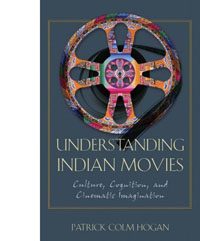 However, at that time Nehruvian socialism was more or less entirely abandoned and replaced with neo-liberalism. In keeping with this, ideologies changed. Perhaps because the consumers of movies became the new middle classes in India and the Diaspora, there was a striking shift in what classes appeared in Hindi cinema and how classes were depicted. As many people have noted, films of the neoliberal period present images of fabulously wealthy Indians and generally focus on Indians whose standard of living is probably in the top few percentage points. . . . I don’t believe this is simply a celebration of wealth and pandering to the self-image of the nouveau riche–though it is that. I believe it is also a celebration of neoliberal policies. Neoliberal policies have been very good for some people. But they have been very bad for others. . . .
However, at that time Nehruvian socialism was more or less entirely abandoned and replaced with neo-liberalism. In keeping with this, ideologies changed. Perhaps because the consumers of movies became the new middle classes in India and the Diaspora, there was a striking shift in what classes appeared in Hindi cinema and how classes were depicted. As many people have noted, films of the neoliberal period present images of fabulously wealthy Indians and generally focus on Indians whose standard of living is probably in the top few percentage points. . . . I don’t believe this is simply a celebration of wealth and pandering to the self-image of the nouveau riche–though it is that. I believe it is also a celebration of neoliberal policies. Neoliberal policies have been very good for some people. But they have been very bad for others. . . .
In this neoliberal cinema (sometimes misleadingly referred to as “globalized”), even relatively poor Indians are commonly represented as pretty comfortable. The difference in attitude is neatly represented by two films by Mani Ratnam—Nayakan (1987) and Guru (2007). The former is a representation of the difficulties of the poor in Indian society. The film already suffers from a loss of the socialist perspective of the 1950s films. Basically, it celebrates an “up from nothing” gangster for Robin Hood-like behavior. (This is an oversimplification, but gives you the idea.)
Guru, by contrast, celebrates a corrupt industrialist who liberates all of India by, in effect, following neoliberal policies against the laws of the government. Neither film offers a particularly admirable social vision. But the former shows the urban poor struggling against debilitating conditions. The latter simply shows a sea of happy capitalists and indicates that lingering socialistic views are preventing India from becoming the wealthiest nation in the world. Part of the propaganda for neoliberalism is pretending that poor people don’t exist any longer–or, if they do, they are just a few who haven’t yet received the benefits.
Paradoxically, then, perhaps local complaints against Slumdog arise because the film took up a subject that hasn’t recently appeared on screens very prominently. The same point seems to be made by Indian commentators and by Indian filmmakers who deplore the fact that none of their number had the courage to make such a movie. The subject demands more probing, but perhaps the outsider Boyle has helped revive interest in an important strain of the native tradition!
Finally, the issue of glamorizing the exotic. Some critics call the film “poverty porn,” but I don’t understand the label. It implies that pornography of any sort is vulgar and distressing, but which of these critics would say that it is? Most such critics consider themselves worldly enough not to bat an eye at naughty pictures. Some even like Russ Meyer.
So is the issue that the film, like pornography, prettifies and thereby falsifies its subject? Several Indian films, like Boot Polish, have portrayed poverty in a sunnier light than Slumdog, yet I’ve not heard the term applied to them. Perhaps, then, the argument is that pornography exploits eroticism for money, and Slumdog exploits Indian culture. Of course every commercial film could be said to exploit some subject for profit, which would make Hollywood a vast porn shop. (Some people think it is, but not typically the critics who apply the porn term to Slumdog.) In any case, once any commercial cinema falls under the rubric of porn, then the concept loses all specificity, if it had any to begin with.
The Slumdog project is an effort at crossover, and like all crossovers it can be criticized from either side. And it invites accusations of imperialism. A British director and writer use British and American money to make a film about Mumbai life. The film evokes popular Indian cinema in circumscribed ways. It gets a degree of worldwide theatrical circulation that few mainstream Indian films find. This last circumstance is unfair, I agree; I’ve long lamented that significant work from other nations is often ignored in mainstream US culture (and it’s one reason I do the sort of research I do). But I also believe that creators from one culture can do good work in portraying another one. No one protests that that Milos Forman and Roman Polanski, from Communist societies, made One Flew Over the Cuckoo’s Nest and Chinatown. No one sees anything intrinsically objectionable in the Pang brothers or Kitano Takeshi coming to America to make films. Most of us would have been happy had Kurosawa had a chance to make Runaway Train here. Conversely, Clint Eastwood receives praise for Letters from Iwo Jima.
Just as there is no single and correct “Indian” or “American” or “French” point of view on anything, we shouldn’t deny the possibility that outsiders can present a useful perspective on a culture. This doesn’t make Slumdog automatically a good film. It simply suggests that we shouldn’t dismiss it based on easy labels or the passports of its creators.
Moreover, it isn’t as if Boyle and Tandan have somehow contaminated a pristine tradition. Indian popular films have long been hybrids, borrowing from European and American cinema on many levels. Their mixture of local and international elements has helped the films travel overseas and become objects of adoration to many westerners.
I believe we should examine films for their political presuppositions. But those presuppositions require reflection, not quick labels. If I were to sketch an ideological interpretation of Slumdog, I’d return to the issue of how money is represented in an economy that traffics in maimed children, virgins, and robotic employees. Money is filthy, associated with blood, death, and commercial corruption. The beggar barracks, the brothel, the call center, and the quiz show lie along a continuum. So to stay pure and childlike one must act without concern for cash. The slumdog millionaire doesn’t want the treasure, only the princess, and we never see him collect his ten million rupees. (An American movie loves to see the loser write a check.) To invoke Neorealism again, we seem to have something like Miracle in Milan–realism of local color alongside a plot that is frankly magical.
Perhaps this quality supports the creators’ claims that the film is a fairy tale. As with all fairy tales, and nearly all movies I know, dig deep enough and you’ll find an ideological evasion. Still, that evasion can be more or less artful and engrossing.
So it seems to me enlightening and pleasurable to see every film as suspended in a web, with fibers connecting it to different traditions, many levels and patches of film history. Acknowledging this shows that most traditions aren’t easily exhausted, and that fresh filmmaking tactics can make them live again. Thinking historically need not numb us to surprises.
The amount of Web writing on Slumdog is exploding. Go to GreenCine for a good sampling of commentary from late 2008. The film’s technique is discussed in Stephanie Argy, “Rags to Riches,” American Cinematographer 89, 12 (December 2008), 44-61. Boyle shows his camera to Darren Aronofsky at Slantfilm. Kim Voynar of Movie City News reviews, critically, the Slumdog backlash.
For a more detailed rationale for this entry’s suspension of value judgments for the sake of analysis, try my earlier blog entry here. Noël Carroll discusses question-and-answer structures in narrative in several books, notably The Philosophy of Horror; or, Paradoxes of the Heart (New York: Routledge, 1990), 130-136. On recent Indian action movies, see Lalitha Gopalan, Cinema of Interruptions: Action Genres in Contemporary Indian Cinema (London: British Film Institute, 2002). The quotations from Giulio Andreotti come from P. Adams Sitney, Vital Crises in Italian Cinema: Iconography, Stylistics, Politics (Austin: University of Texas Press, 1995), 107; and Millicent Marcus, Italian Film in the Light of Neorealism (Princeton: Princeton University Press, 1986), 26.
Thanks to Cathy Root, who is at work on a book on Bollywood, for advice and links. Thanks as well to Patrick Colm Hogan and Lalita Pandit for corrections, information, and ideas.
PS 2 Feb: David Chute, expert on Indian cinema, has written a helpful and balanced entry on Slumdog at his Hungry Ghost site.
PPS 14 Feb: From another expert on Indian film, Corey Creekmur, at the University of Iowa, some further ideas and references on the childhood motif:
I would emphasize that establishing a film’s narrative direction through childhood events is a dominant narrative trope in popular Indian cinema, animating many famous “golden age” examples, including Raj Kapoor’s Awara (1951), Mehboob Khan’s Anmol Ghadi (1946), and Bimal Roy’s Devdas (1955), along with a number of the major 1970s films starring Amitabh Bachchan, which often carry childhood traumas into the adult character’s life. The story of brothers growing up on two sides of the law is also a Hindi film staple, central to Bachchan’s emergence as a superstar in Deewar in 1975. It seems to me curious that Slumdog Millionaire’s Western filmmakers draw on these conventions more fully than the source novel [Q & A] by a non-resident Indian does.
I attempt to explain the decades-long cultural function (and eventual waning) of this narrative trope — often achieved through a specific formal device (a dissolve from boy to man) moving from the lives of children to adults (skipping over adolescence) that I call the “maturation dissolve” — in an article “Bombay Boys: Dissolving the Male Child in Popular Hindi Cinema,” in Where the Boys Are: Cinemas of Boyhood, ed. Murray Pomerance and Frances Gateward. (Detroit: Wayne State UP, 2004). In that essay I suggest that some of the Hollywood examples — as well as Citizen Kane — you mention could have inspired the Indian examples, but also suggest certain Indian sources (the childhood love of the god Krishna and his consort Radha, which informs all versions of Devdas) as well. Since I’m citing myself, I’ll also note a recent essay on the “Devdas” phenomenon in Indian cinema: “Remembering, Repeating, and Working Through Devdas,” which appears in Indian Literature and Popular Cinema: Recasting Classics, ed. Heidi R. M. Pauwels (Routledge, 2008). By the way, you might also enjoy a website devoted to popular Hindi cinema by my colleague Philip Lutgendorf (with whom I regularly teach Indian cinema classes). Most of the entries on his site are his, but as you will note, sometimes he lets me put my two cents in there as well: http://www.uiowa.edu/~incinema/
PPPS 21 February: Several scholars comment on the film’s representation of the Dahravi neighborhood and the multilayered significance of Indian protests against Slumdog. See today’s New York Times here and here.












